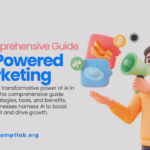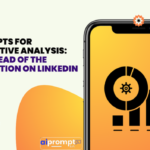
Discover the latest AI prompts for ad targeting on social media. Learn how to optimize your campaigns, increase engagement, and reach your target audience effectively with AI-driven strategies.
Businesses spend a significant portion of their budget looking for fresh ideas that will help them utilize their ad-targeting strategies to the maximum. Now AI engines have conquered their kingdom in the space where the lives of men are at risk, in the health domain. AI processing power stands at the very helm of highly precise analysis of user data as well as guarantees advertisers the possibility to target specific audiences thus significantly enhancing campaign efficiency.
Understanding AI-Powered Ad Targeting
AI algorithms such perfect for the analysis of various data and making predictions based on the identified patterns of the user’s behavior. By looking at actual data, including demographics, hobbies, and web behavior, AI can collect the information required for the creation of user profiles. So, this enables advertisers to send their ads more precisely making sure that the right type of audience will get the right message at the right moment.
Here are the 10 best AI prompts for ad targeting on social media.

Demographic Targeting: As for me, “Focus on the relevant demographic segments determined by age, gender, and location for the ad campaign of our brand. Use the data to target the ads more accurately.
Interest-Based Targeting: “Track users’ interests by their online activity and segment them according to the most relevant interest categories. Then successfully align your ads with those categories for greater outcomes. “
Behavioral Targeting: “To capitalize on audience segmentation through user behavior data, we will abandon low-intent audiences. Therefore, our ads will be displayed to users who have shown their interest by demonstrating behavior known to lead to conversion. “
Lookalike Audience Targeting: “Establish lookalike audience segments derived from sorts in our existing customer data; use them to broaden exposure to new users who are similar to our customers.
Dynamic Ad Content: “Utilize dynamic ad content with ad customization, which will personalize our ads for each user by their preferences and behavior. Ensure the ad content is relevant and will engage the users.
Contextual Targeting: “Analyze the context of web pages to determine the most relevant ad placements. Target our ads to pages where they will be most effective.”
Remarketing: “Target our ads to users who have previously visited our website or app but did not complete a desired action. Encourage them to return and complete the action.”
Predictive Targeting: “Use predictive analytics to identify users who are likely to take a specific action, such as making a purchase. Target our ads to these high-potential users.”
Cross-Device Targeting: “Track user behavior across multiple devices to ensure our ads reach users on the device they are currently using. Optimize our ad targeting for cross-device engagement.”
Ad Creative Optimization: “Optimize our ad creative elements, including headlines, images, and calls-to-action, using AI. Test different variations to determine the most effective creative for our ad campaign.”
Benefits of AI-Powered Ad Targeting
Improved Audience Targeting: Artificial intelligence makes it possible for advertisers to reach specific segments of the audience based on their preferences, behavior, and characteristics, thus helping them to display the ads to the audience who will be most probably interested in them.
Enhanced Campaign Performance: AI helps a lot in this by narrowing the audience who will receive the information, thus the return on investment as well as other important metrics like click-through rates (CTR) and conversions will improve.
Cost-Effectiveness: AI enables the refining of the ad spend by conveying the consumer message to audiences that are more active and probably to purchase, to avoid impression loss and to up the ROI.
Personalized Ad Experiences: The ads displayed using AI targeting make it possible for the advertisers to generate more interactive ads for specific users, hence, leading to an increased chance of engagement and conversion.
Real-Time Optimization: Through AI algorithms advertisers can process data in real-time helping them refine their ads and adjusting their campaigns for better results.
AI-Powered Ad Targeting in Action: Case Histories
Netflix: Netflix uses AI-based algorithms that are tailored to analyze the behavior and tastes of users, making the content suggested to the users very personalized. This also plays a key role in the provision of quality services for the existing subscribers, and facilitating fan engagement.
Amazon: Amazon brings AI-driven ads on its Platform, identifying user behavior and purchase history to place its outputted product selections. As a result, sales have increased and at the same time, customers are delighted with the brand.
Facebook: Facebook is using AI for the ads, defined as targeting individuals with consideration to their behavior, interests, and other demographic indicators. This has proven Facebook as the greatest platform where advertisers can effectively promote their businesses.
Future Trends in AI-Powered Ad Targeting
Increased Use of Machine Learning: From more intricate machine learning algorithms for online ad targeting to a stage when the accuracy is improved by laser precision personalization, as AI technology advances we can understand the AI trend for the near future.
Integration with Voice Assistants: As voice search and smart speakers look to be on the rise, it is possible that AI-guided ad targeting would be integrated into voice assistants to make ads based on voice commands and user behavior as the main outlet.
Enhanced Data Privacy and Security: Since privacy and security issues remain hot topics, we will be able to see ads targeting AI solutions that are more privacy-focused and abide by laws such as GDPR or CCPA.
Last Words
AI-driven ad-targeting changes the face of social media advertising in the way businesses operate. Through AI the power of it can be utilized by advertisers to create shorter and highly personalized ad campaigns; thanks to this engagement, conversion rates and ROI are expected to improve. Along with the development of AI technology further, it is going to result in accomplishing more unique applications of AI in the sphere of targeted advertising of customers, which will define the future of digital marketing.






